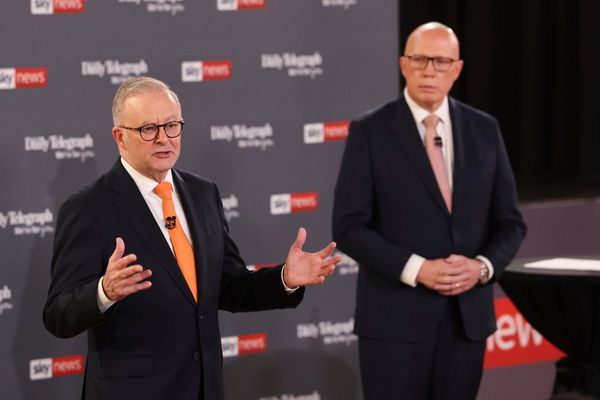
Jock McFadyen’s London is an eerie place: a derelict sprawl of abandoned buildings, industrial sites and boarded-up shopfronts. His territory is “the edges of the city where it gives away to the landscape”, he says, and paints transitional spaces that are in between uses, or on the way to somewhere else.
Olympia (2015) shows the graffiti-covered hoarding of a Hackney building site, with the Olympic Stadium and Anish Kapoor’s Orbit sculpture just visible above; Cambridge Heath (2004) depicts an empty petrol station against a tumultuous night sky; Elephant (1996) reveals a deserted underground platform, all peeling paint and ominously hanging cables, a no-smoking sign the only hint of habitation.
Two decades of McFadyen’s London paintings are gathered in Tourist Without a Guidebook at the Royal Academy of Arts, London, the last of four exhibitions planned to mark his 70th birthday in September 2020 (the series was delayed by the pandemic). Also on show at the Lowry in Manchester are works spanning 45 years, interspersed with paintings by LS Lowry, one of McFadyen’s favourite artists. The exhibition at the Royal Academy brings together works made in the early 1990s with pieces completed under lockdown, including old paintings that McFadyen has reworked. All explore the hidden life of the city and its inhabitants, real or imagined.
Born in Paisley, McFadyen came to London to study at Chelsea College of Art, and, since graduating in 1977, has stayed in the city. At art school, he made “witty, schematic, pop art-influenced pictures which got me enough money for a deposit on a flat and a shiny car”. But after a residency at the National Gallery in 1981 surrounded by Titians and Rembrandts, McFadyen lost faith in his caricatural figures and decided to change tack.
“I went out with a pencil and started sketching things I’d actually seen, rather than wallowing in things that I’d invented,” he says. And what he saw was the changing East End. In the early 1970s, his part of east London was “grainy black and white, not many cars, a lot of poverty. Very much low rise.” Heavily bombed during the blitz, much of the area is now unrecognisable following years of redevelopment. Now, from his bedroom window, McFadyen can see the Gherkin in one direction and Canary Wharf in the other, as if “surrounded by the pincer movement of money”.
He compares the process of painting to being in a speedboat driven by someone else: you can start out with a plan, but have to be prepared to let it go. He started his career painting figures in the urban landscape – often based on strangers he’d photographed with a long-lens camera, “like a stalker” – but soon found they were getting smaller. “The painting itself was telling me that I was painting places,” he says, “when I thought I was painting people.” He abandoned figuration almost entirely in the early 1990s, but in recent years his practice has come full circle. Two years ago he began sketching nightclub scenes, inspired by memories of student life: carnivalesque depictions of grotesquely distorted figures (“How can anyone try to be straightforward about depicting humans?”).
Asked to describe his relationship with London, McFadyen quotes Lord of the Flies: “As Piggy says about Ralph, when you really get to know someone you hate them. I’ve got a love-hate relationship with London.” Yet he’s not planning on leaving: “What London has is endless people. You really have the biggest pool of life here.”
Toast of London
Jock McFadyen on four of his cityscapes

Roman Road 4, 2007
“When I moved to Bethnal Green in 1989 my elderly neighbours refused to call it Roman Road [the name changed in the 30s]: ‘It was Green Street when we were kids … ’ The view is looking west from Market Square, an empty plot created by the Nazi bombing in the 1940s.”
From the Greenway 3, 2003 (main picture, above)
“In 2003, the writer Iain Sinclair invited me on a stroll along the top of the main sewage outflow pipe from Stratford to Beckton. A difficult offer to refuse: in 2001 he had referred to me as ‘the laureate of stagnant canals and night football pitches’, one of the best compliments of my career. This is the view on the walk back in the falling light.”

Elephant, 1996
“London is a building site and it changes before your eyes. The tube stations are either high-end glass and steel or in between upgrades. The crappier ones have surfaces which are irresistible to paint.”

Nightbus, 2020
“During lockdown, I reworked a group of older pictures made when my pictures were almost exclusively figurative. Most night travellers in London are drunk, and in order not to be intimidated, it’s best to be drunk oneself. Distortion happens, and in the tradition of artists like Picasso, Bacon or Lowry, distorted figures can have more fidelity than attempts at realism or portraiture.”
Jock McFadyen RA: Tourist Without a Guidebook is at the Royal Academy of Arts, London, to 10 April; Jock McFadyen Goes to the Lowry is at the Lowry, Manchester, to 27 February.







